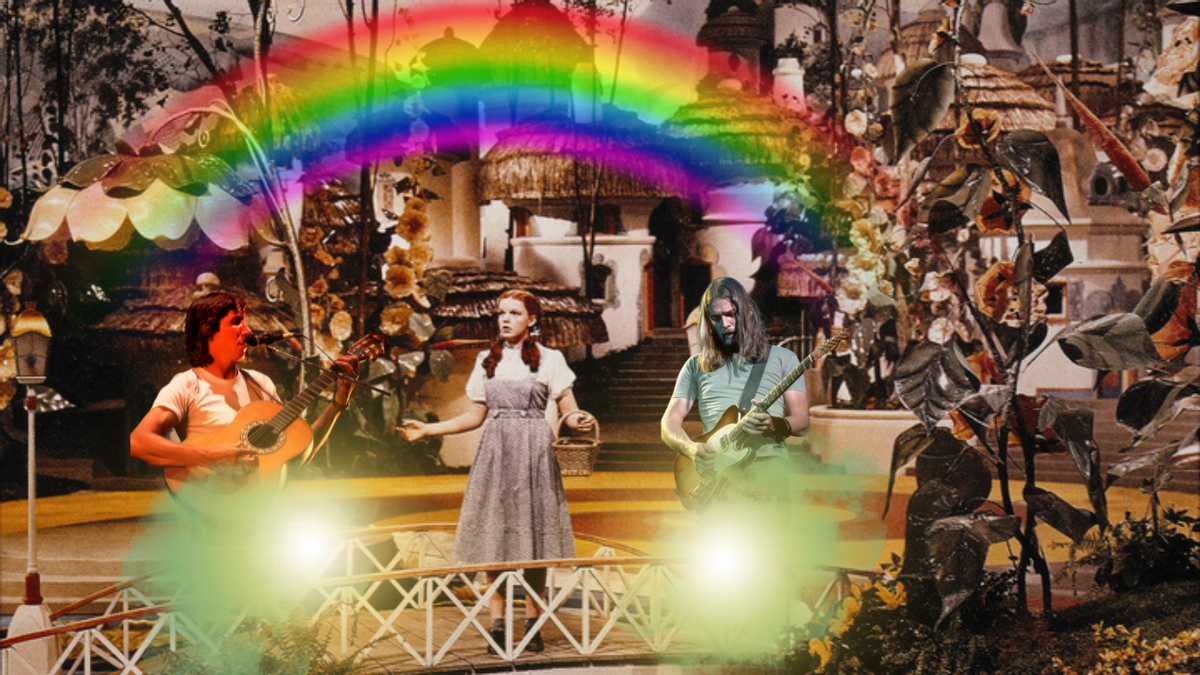The ongoing discussion theorizing a synchrony between Pink Floyd's iconic 1973 album "The Dark Side of the Moon" and the classic 1939 film "The Wizard of Oz" has been raging for decades, captivating film buffs and classic rock fans while sparking widespread discussion on social media and in blogs. The theory first gained traction in the 1990s and has persisted since then, fueled by enthusiasts who claim to have experienced the alleged synchronization firsthand.
In the early '90s, a fascinating phenomenon dubbed "Dark Side of the Rainbow" captured the public imagination. As internet forums gained prominence, discussions surrounding the alleged harmonic coordination of the film with the album proliferated. Fans shared anecdotes and insights, contributing to the perpetuation of the rumor across various platforms. Over time, the theory evolved from a niche fascination to a widely recognized cultural phenomenon, attracting attention from fans and media outlets.
Despite many anecdotal accounts of coincidental alignments between the album's tracks and the film's scenes, the lack of concrete evidence coupled with consistent denials from the band members and studio production team regarding any deliberate synchronization of the album with the movie have eroded the credibility of the claim.
Throughout the years, members of Pink Floyd have addressed the rumor of their album's intentional synchronization with the movie. Guitarist and co-lead vocalist David Gilmour dismissed the idea, saying "Some guy with too much time on his hands had this idea of combining 'Wizard of Oz' with 'Dark Side of the Moon.'"
In an MTV article published in 1997, "The Dark Side of the Moon" sound engineer, Alan Parsons, said, "There simply wasn't mechanics to do it. We had no means of playing videotapes in the room at all. I don't think VHS had come along by '72, had it?"
Additionally, in the same MTV story, Pink Floyd drummer, Nick Mason, joked of the theory, "It's absolute nonsense, it has nothing to do with 'The Wizard of Oz.' It was all based on 'The Sound of Music.'"
In his 2022 appearance on The Joe Rogan Experience podcast, co-lead vocalist and bassist Roger Waters told Rogan that the synchronization was "bulls***" and "has nothing to do with us."
The popularization of the phenomenon can be traced back to an article published in 1995 by Charles Savage in The Fort Wayne Journal Gazette. Savage suggested an intriguing experiment: Watching "The Wizard of Oz" while simultaneously listening to "The Dark Side of the Moon." The author credited the initial idea to a poster in an early-'90s online message board for Pink Floyd, who apparently wrote that "he or she'd heard about it from 'some people down in Los Angeles.'"
Savage described the audio-visual experience as "astonishing," noting that when one hits play on the album as the MGM lion roars for the first time on screen (some people who've tried it suggest it's best to hit play on the lions third roar), a remarkable synchronicity unfolds. He observed that the music seemed to align with the film's action and plot, creating an immersive fusion of sound and imagery. The lyrics and titles of the album's songs appeared to correspond with certain on-screen events, leading to moments of uncanny coincidence. For example, according to Savage:
- During "Breathe," Dorothy does a tightrope-like walk along the holding pen to the lyric "and balanced on the biggest wave."
- The line "no one told you when to run" from "Time" is sung just as the scene switches to Dorothy running away from home to save Toto.
- "Home, home again" from the "Breathe" reprise is sung as the fortuneteller tells Dorothy to go home.
- "Don't give me that do goody good bullshit" from "Money" comes as Glinda the Good Witch of the North floats in as a bubble.
- "Black... and blue" from "Us and Them" is sung as the Wicked Witch of the West appears dressed in black. That is shortly followed by "and who knows which is which" (witch is witch) as she and Glenda confront each other.
- "Brain Damage" - which begins at almost the same time as the movie's "If I Only Had a Brain" - contains the lines "The lunatic is on the grass" and "Got to keep the loonies on the path." This is just as the Scarecrow flops around like a madman on the grass and then on the Yellow Brick Road.
Savage's article sparked widespread interest and inspired fans to delve deeper into the phenomenon.
Another early mention of this phenomenon comes from a 1997 article by Helen Kennedy from the New York Daily News, in which she name-checks Boston radio personality George Taylor Morris of WZLX-FM as an originator of the theory.
Enthusiasts have created dedicated YouTube posts, articles and artworks to document their experiences and catalog moments of synchrony between the album and the film.
Publications such as Mojo4Music and The New York Times have also delved into the history of this phenomenon while analyzing the validity of the claim, exploring both the origins of the rumor and its enduring appeal.
The phenomenon and legacy of "Dark Side of the Rainbow" continues to captivate audiences to this day, solidifying its place in popular culture and fueling ongoing fascination with the intersection of music and film.
Despite the rumor continuing to persist and circulate on social media platforms, the claim that Pink Floyd's "The Dark Side of the Moon" was created to synchronize with "The Wizard of Oz" is false. While the idea of such synchronization may have sparked curiosity and inspired creative interpretations among fans, the available evidence suggests it is a product of coincidence rather than deliberate design.

